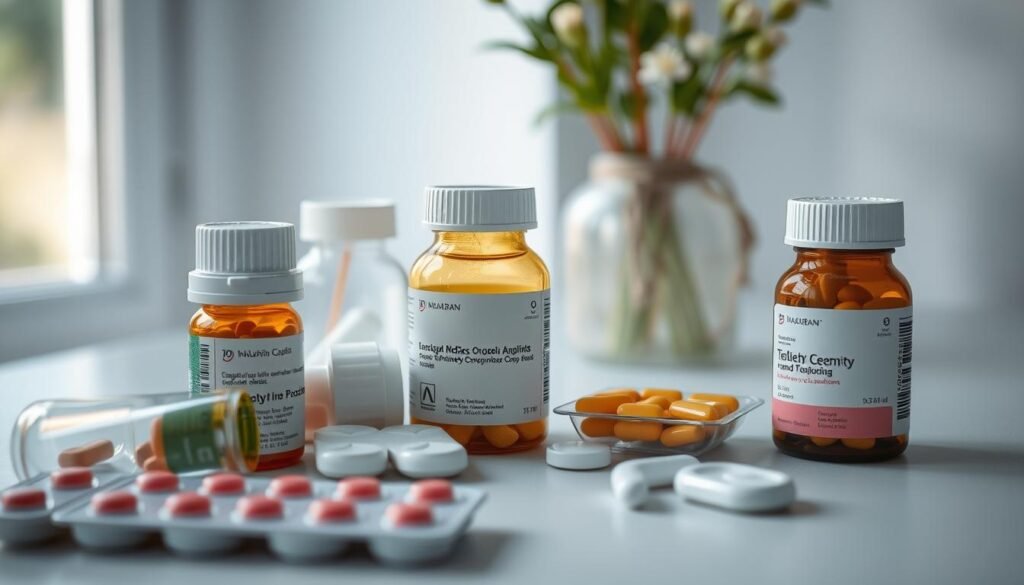Approximately 40 million adults in the United States struggle with anxiety. It’s the number one mental health issue in the country. Klonopin, also called clonazepam, is often used to help these individuals. While it’s mainly for seizure and panic disorders, it can also help with anxiety.
Understanding the right Klonopin dosage for anxiety is crucial. It helps patients get the relief they need while avoiding risks. This article will cover Klonopin doses for anxiety and how to use it safely.
Key Takeaways
- Klonopin is primarily used for seizure disorders and panic disorders.
- Typical starting dosages for anxiety management vary based on the condition.
- Maximum recommended dosages are important to prevent overdose risks.
- Regular consultation with a healthcare provider is vital for dose adjustments.
- Potential side effects and risks need careful consideration before use.
Understanding Klonopin
Klonopin, also known as clonazepam, belongs to the benzodiazepine family. It’s mainly used to treat anxiety and seizures. It quickly works to calm and reduce anxiety symptoms.
Klonopin is found in tablet form and comes in 0.5 mg, 1 mg, and 2 mg strengths. There are also orally disintegrating tablets for easier use. The usual starting klonopin dosage for anxiety is 0.25 mg twice a day. The goal is to reach 1 mg daily.
Clonazepam works by calming the brain’s nerves. It changes neurotransmitters to bring about peace and reduce anxiety. However, it can cause drowsiness, dizziness, and weakness. More serious side effects like confusion and slurred speech need doctor’s attention.
It’s vital to handle Klonopin responsibly because it’s a controlled drug. Sharing it is a no-go, and it must be kept away from kids. This prevents misuse and addiction.
Klonopin and Its Uses
Klonopin, or clonazepam, helps people with panic disorder treatment. It is very useful for those who have panic attacks, with or without agoraphobia. It’s mainly for certain anxiety conditions, not all anxiety kinds. Knowing klonopin uses helps understand how it aids in treatments.
Besides panic disorder, Klonopin treats seizures like absence and myoclonic seizures. It’s vital to follow the klonopin anxiety medication dosage closely to avoid problems.
People allergic to similar medicines, or with liver issues or certain glaucoma, should not take Klonopin. The elderly must be especially careful due to possible confusion and sleepiness. This makes choosing the right treatment very important.
For Klonopin to work best in controlling panic attacks, using it correctly is key. Knowing about side effects and interactions is also crucial. For more on dosages and safety, talking to a healthcare provider or checking resources like guides on Klonopin is wise.
How Klonopin Works for Anxiety
Klonopin, or clonazepam, is key in fighting anxiety, especially panic disorder. It boosts gamma-aminobutyric acid (GABA), a neurotransmitter that limits too much neural activity. This action helps calm the brain, reducing anxiety and panic attacks effectively.
For panic disorder, the usual klonopin dosage anxiety treatment is from 0.5 mg to 4 mg a day, mostly taken twice. People with seizure issues often take 1.5 mg to 20 mg daily, in three separate doses. Klonopin comes in 0.5 mg, 1 mg, and 2 mg tablets, so patients have options.
Klonopin is a strong klonopin anxiety relief dosage, but watching for side effects is crucial. These can include feeling sleepy or dizzy, and low blood pressure, which might cause orthostatic hypotension. There’s a risk of depression and having suicidal thoughts, so regular checks with doctors are critical.
Klonopin is highly effective in controlling anxiety when used correctly. For detailed dosing info, checking out medical literature, such as dosage recommendations, is recommended.
Klonopin Dosage for Anxiety: What You Need to Know
Knowing the right amount of Klonopin for anxiety is key. It helps treatment work well and lowers side effects. Always talk openly with your doctor to get the right plan.
Typical Starting Dosages
Starting doses for panic usually begin at 0.25 mg twice daily. Adjustments may be needed based on individual reactions. For seizures and muscle spasms, 1 mg at night is common. This can go up to 4 to 8 mg over 2 to 4 weeks, as per the doctor’s advice.
Maximum Recommended Dosages
For panic, doses range from 1 to 2 mg daily, not exceeding 4 mg. Seizure treatments may go up to 20 mg daily. Older adults or those with health issues might take less. If used for more than four weeks, a slow dose reduction is suggested to prevent withdrawal.
Watching for symptoms like dizziness and tiredness is crucial when adjusting doses. Always consult a doctor when adjusting for safety and effectiveness. Learn more about klonopin dosage for anxiety management.
Forms and Strengths of Klonopin
Klonopin comes in oral tablets and orally disintegrating tablets (ODT). You can find oral tablets in strengths of 0.5 mg, 1 mg, and 2 mg. This variety meets the different needs of patients. People usually take these tablets two or three times daily.
For those who find pills hard to swallow, the orally disintegrating tablets are a great option. Here are the available klonopin dosage forms:
| Strengths (mg) | Form |
|---|---|
| 0.125 | ODT |
| 0.25 | ODT |
| 0.5 | ODT & Oral Tablet |
| 1 | ODT & Oral Tablet |
| 2 | ODT & Oral Tablet |
This variety lets doctors customize doses for the best results and safety. Adults with seizure disorders often start with no more than 1.5 mg daily. But they can take up to 20 mg if needed. For panic disorder, the starting dose is usually 0.25 mg twice a day. The maximum dose for this condition is 4 mg daily.
Children under 10 years or those who weigh less than 30 kg start with 0.01 to 0.03 mg/kg/day. This shows how treatment must be tailored to each individual.
Dosage Adjustments for Individual Needs
Adjusting the Klonopin dosage is vital for customizing treatment. It depends on how severe the anxiety is, patient’s reaction to the medication, and interaction with other drugs. Age, weight, and how well the kidneys function also influence the dosage.
For adults with panic issues, the starting dose is usually 0.25 mg twice a day. For seizures, it begins at 0.5 mg three times a day. The dosage is then adjusted every few days. The goal is to find the best dose with the least side effects.
Dosage for kids depends on their age and how much they weigh. It’s typically between 0.01 to 0.03 mg per kilogram of their body weight. Younger patients, under ten, start with a closely monitored dose. It’s increased slowly to get the right effect while watching for any side effects.

Long-term Use of Klonopin
Klonopin is often used for treating anxiety and seizures. But, using it for a long time has risks. Knowing about the risks of Klonopin dependence is crucial as they grow over time.
Risks of Dependence
The longer you use Klonopin, the more likely you are to need more of it. This is because your body gets used to the drug. Needing more medication can increase the risks linked to long-term use. Dependence can start after just two weeks of daily use.
Quitting Klonopin can lead to tough symptoms. These include dizziness, nightmares, and mood swings. These symptoms make detoxing hard but very important. The risks of stopping suddenly are serious. They can cause seizures and harm your brain.
A lot of people in the U.S. use Klonopin. Over 20 million prescriptions are filled out each year. Benzodiazepines like Klonopin were involved in 16% of drug deaths in 2020. Long-term use can also raise the risk of Alzheimer’s by up to 51%.
Doctors are talking more about the risks of Klonopin dependence nowadays. They advise patients on how to safely manage their treatment for a long time.
Potential Side Effects of Klonopin
Klonopin, while effective for managing anxiety and certain seizure disorders, can lead to a variety of klonopin side effects. Some people might feel tired, dizzy, or less alert. These effects can make everyday tasks hard, especially those that need you to be fully focused.
Some users face serious issues. There are cases of suicidal thoughts, difficulty in thinking, and severe allergic reactions. Combining Klonopin with other drugs that slow down the brain can be very dangerous.

There’s also a chance for surprising reactions, especially in kids. They might get more restless instead of calm. Knowing these possible klonopin dosage effects is crucial for anyone using or thinking about using Klonopin.
Over time, Klonopin can cause more problems like harming memory. It also has a high risk of addiction, as it’s a Schedule IV drug. Anyone taking it for a while should regularly check in with their doctor to adjust the treatment if needed.
Prescription Guidelines for Klonopin
Klonopin should only be given out by experts who understand a patient’s health needs well. Doctors consider the patient’s health past and any other existing issues. Patients must follow the klonopin dose rules from their doctor to be safe and get good results.
The common starting doses for Klonopin are 0.5 mg, 1 mg, and 2 mg pills. Adults with panic issues often start with 0.25 mg twice a day. They can take up to 4 mg a day, split into two doses. Adults with seizure problems usually start with 0.5 mg three times a day. The max dose for seizures can go up to 20 mg a day, spread out in smaller doses.
For kids, the dose depends on their age and weight. Children with seizures start with 0.01 to 0.03 mg/kg of their body weight. They might need between 0.1 and 0.2 mg/kg a day to maintain their health. This method helps adjust the medicine based on how the child responds. It also aims to lower the risk of becoming dependent over time.
| Condition | Starting Dosage | Maximum Dosage |
|---|---|---|
| Panic Disorder (Adults) | 0.25 mg twice per day | 4 mg per day (2 mg twice daily) |
| Seizure Disorders (Adults) | 0.5 mg three times per day | 20 mg per day |
| Seizure Disorders (Children) | 0.01 mg to 0.03 mg/kg | 0.1 to 0.2 mg/kg per day |
It is vital to understand that Klonopin is a controlled drug because it can be misused. Therefore, doctors must watch patients using this medicine closely. They check if the treatment works and make dose changes if needed. This ensures the patient’s safety and the best possible results from the treatment.
Drug Interactions and Precautions
Klonopin is a common prescription for anxiety and seizure problems. It’s important to know about klonopin drug interactions. Different meds can change how well it works or cause bad side effects. Telling all meds and supplements to your healthcare provider helps avoid risky problems.
Medications to Avoid
Some meds shouldn’t mix with Klonopin because they might increase its effects or harm your health. You should not take:
- Other benzodiazepines
- Opioids
- Antipsychotic drugs
- Antidepressants
- Stimulant medications
- Sedative hypnotics
- Certain antifungal medications
Mixing Klonopin with opioids can very much make you sleepy and slow your breathing, which is dangerous. Drinking alcohol with Klonopin boosts these dangers, causing big-time central nervous system depression.
Consulting Your Healthcare Provider
Always talk about klonopin precautions with your doctor. Important to mention any health issues like liver problems or glaucoma that might make Klonopin a bad choice. Also, ask about what foods or drinks, like grapefruit, that could interfere with the drug.

Keeping up open talks with your healthcare team ensures Klonopin is safe and effective for your needs.
The Importance of Adhering to Prescribed Dosage
Following the right dosage of klonopin is key for handling anxiety well. In the U.S., over 40 million adults face anxiety yearly. Hence, getting the dosage right is hugely important. Klonopin, also known as clonazepam, should usually be taken for a month or less. The highest dose allowed is two milligrams each day.
Not sticking to the given dosage plan can lead to big problems. If you don’t follow the plan, your symptoms might not improve much. Plus, you could face serious side effects like feeling sleepy, dizzy, or uncoordinated. If you stop taking the medicine suddenly, you might get headaches, feel irritable, or confused.
It’s important to take your medication at the same times every day. This habit helps make sure the drug works as well as possible, which is often within four hours of taking it. Talking openly with your doctor about any issues or side effects is also crucial during your treatment.
By carefully following your prescribed dosage of klonopin, you can significantly better your life. It can make a huge difference in managing your anxiety. This helps lessen the overall effect of the condition on your life.
Conclusion
Klonopin is key for many with anxiety and panic issues. When followed right, it brings good results. Knowing how much to take, the side effects, and dependence risks is key.
This drug stands out among others due to fewer bad effects, studies show. Always talk to a doctor before starting. A well-planned klonopin dosing summary lowers risks and boosts benefits. It’s important to know how it works with other meds.
Keep an eye on how you use Klonopin. It helps get the most out of it and catches side effects early. Steady check-ups are a must for anyone on this path.